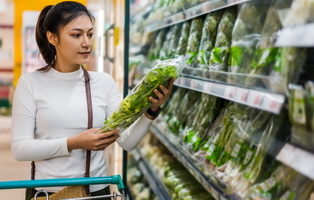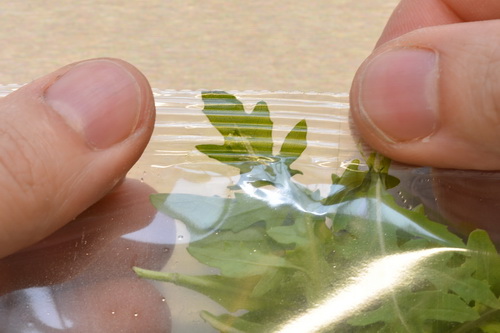
The sealing of flexible packages is a critical phase in the packaging process for fresh produce manufacturers. Wrinkles, folds, and product in the sealing area are the main causes of leaking packages. As fresh produce is often packed under modified atmosphere conditions, even the smallest leaks reduce shelf life, induce changes in taste, pose health risks, and may also lead to expensive re-calls with potential brand damage.
DOWNLOAD PDF
Fresh produce is a huge market with millions of packages produced, sold and consumed daily. Many seal inspection processes are still based on off-line and manual inspection, but with increasing quality demands and higher productivity requirements, these systems are no longer adequate. Better alternatives are in-line, non-destructive seal inspection technologies, but for flexible packaging these are challenging. For example, standard vision camera inspection systems have many limitations for flexible packaging due to often non-transparent films, reflections, and the deformation of the packages. Infrared cameras have consistency issues due to environment and timing. But with Engilico, this seal inspection is efficiently possible. Engilico offers SealScope®, an in-line, non-destructive seal inspection and process monitoring device for flexible packages such as pillow bags, pouches and flow-packs.
SealScope® offers a unique approach to in-line seal inspection. Sensors are installed on the sealing jaws of the packaging machine and measure during the closing of the sealing jaws. Every time a package is sealed, the actual measurement is compared to a reference model of correctly sealed packages. In case the deviation is higher than a user defined limit – due to product in seal, or wrinkles or folds in the seals-, SealScope® will issue a rejection signal and the package is excluded via an ejecting system. This automated 100% inspection leads to immediate benefits. Every single package is inspected, so manual inspection can be eliminated. By rejecting the defective packages, the outgoing quality is instantly increasing, inducing less rework and lower scrap.
Fresh produce, a delicate product for seal inspection
Packaging fresh produce is often done using vertical-form-fill-seal machines (VFFS) under modified atmosphere to preserve the freshness of the vegetables. Therefore, package integrity is important to warrant shelf life. The critical points of the packaging process are the filling and subsequent sealing of every bag. Vegetables in chunks or parts, such as carrots, broccoli are easy to detect when they are stuck in the seal. During the filling phase, gravity makes these products fall directly in the bags and mainly during overfill or stacking, product can get stuck in the seal. Larger parts in the seal are easily detected by the SealScope® sensors and as such, automatic rejection of defective packages is straightforward.
 A bigger challenge is the seal inspection of sliced vegetables, leafy greens or salads. Because these products are lightweight, they swirl during the filling and tend -as they are often wet- to stick to the inner bag sides. Also, as the filling is not 100% controlled, it often occurs that the seal bars are already closing when the last leaves are falling. Because the leaves are light, they are often completely crushed due to the pressure of the sealing. So how is Engilico detecting small fresh produce particles in the sealing area? For applications – such as fresh produce – that contain a high amount of water, Engilico uses highly sensitive sensors that are mounted on the sealing bars. These sensors are able detect the slightest deviations during the closing of the sealing bars. Every individual seal measurement is compared to a reference seal and when product is present in the seal, a deviation is detected, and the bag is rejected.
A bigger challenge is the seal inspection of sliced vegetables, leafy greens or salads. Because these products are lightweight, they swirl during the filling and tend -as they are often wet- to stick to the inner bag sides. Also, as the filling is not 100% controlled, it often occurs that the seal bars are already closing when the last leaves are falling. Because the leaves are light, they are often completely crushed due to the pressure of the sealing. So how is Engilico detecting small fresh produce particles in the sealing area? For applications – such as fresh produce – that contain a high amount of water, Engilico uses highly sensitive sensors that are mounted on the sealing bars. These sensors are able detect the slightest deviations during the closing of the sealing bars. Every individual seal measurement is compared to a reference seal and when product is present in the seal, a deviation is detected, and the bag is rejected.
Also wrinkles and folds during the sealing can result in open packages, leading to product returns and shorter shelf life. As fresh produce packaging is done at high speeds, the flexible packaging materials are under high strain and can be subject to deformations causing wrinkles. As well as product in the seal, bags with folds, wrinkles or tapered seals are detected by the SealScope® sensors and rejected.
Optimizing the packaging process for fresh produce
The immediate role of SealScope® is detecting and rejecting residual packaging defects, thereby optimizing the outgoing packaging quality. The sensitivity of the rejection level can be set according to the customer’s quality policy to find the right balance between outgoing quality and rejected packages.
As every process will eventually experience drift, variations in productivity and packaging quality start to increase. Drift can be caused by e.g., dirt accumulation on the sealing jaws, wear on moving parts, etc.
SealScope® continuously monitors the sealing process, allowing the operators to take corrective actions – for instance preventive cleaning of the sealing station. As such, the SealScope® monitoring tool, allows to avoid further process drift and to keep the machine in optimal shape.
Straightforward integration on new or existing packaging lines
The SealScope® solution consists of one or multiple sensors that are connected to the sealing bars, an industrial cabinet with touchscreen UI and the intuitive SealScope® software. This compact layout and Engilico’s experience in retrofitting to leading packaging machine brands such as PACRAFT, (Toyo Jidoki), Leepack, ULMA, GEA, Omori, SN, MesPack, HDG guarantee an easy integration of SealScope®. SealScope® today is installed on 200+ packaging lines at international customers in the food, pet care and other applicable industries.
